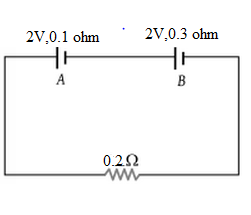
The internal resistance of two cells shown are \[0.1\Omega \] and \[0.3\Omega \]. If \[R = 0.2\Omega \], the potential difference across the cell:

A) B will be zero
B) A will be zero
C) A and B be \[2V\]
D) A will be \[ > 2V\] and B will be \[ < 2V\].
Answer
135k+ views
Hint: According, Kirchhoff’s voltage law (KVL), the algebraic sum of voltages across each element is zero. Kirchhoff’s voltage law is used to calculate the value of potential difference across the cell. From KVL, We get the value of current flowing through the circuit. Then we calculate potential difference across B by substituting the value of current in the KVL equation.
Formula used:
We apply Kirchhoff’s voltage law (KVL) in circuit. Then we calculate potential differences across B.
Complete step by step solution:
Given: Resistances are \[0.1\Omega \], \[0.3\Omega \] and \[0.2\Omega \]. Voltages are \[2V\] each.
Let us suppose that the current flowing through the circuit is I.
On applying: Kirchhoff’s voltage law (KVL) in given circuit , we get following equation
\[ - (0.2)I - (0.3)I + 2V - (0.1)I + 2V = 0\]
\[ \Rightarrow 0.6I = 4\]
\[ \Rightarrow I = \dfrac{4}{{0.6}} = \dfrac{{40}}{6}A\]
\[\therefore I = \dfrac{{20}}{3}A\]
Hence, current flows through the circuit, \[I = \dfrac{{20}}{3}A\]
Now, potential difference across B is calculated by
\[{V_1} - (0.3)\dfrac{{20}}{3} + 2V = {V_2}\]
\[ \Rightarrow {V_1} - 2V + 2V = {V_2}\]
\[ \Rightarrow {V_1} = {V_2}\]
\[\therefore\] Potential difference across \[B = {V_1} - {V_2} = 0\]
Hence, Potential difference across B is zero.
Therefore, the correct option is (D).
Additional information: Kirchhoff’s voltage law (KVL) is also known as the second rule of Kirchhoff’s. According to this rule, the algebraic sum of voltages in a closed circuit is zero. Kirchhoff’s voltage law is applicable for both AC and DC circuits. Voltage across passive elements in a closed circuit is always equivalent. The value of voltage is reverse to source voltage.
To measure the unknown standards such as current (I), Voltage (V) we use, Kirchhoff's laws are used, KVL is also used to find the direction of moving current in the circuit. This rule is very useful to solve complicated circuitries. To observe the transferal of power in the circuit, we use KVL in circuits.
Note: Students be careful to apply Kirchhoff’s voltage law (KVL) in circuit. Direction of current is mandatory to apply Kirchhoff’s voltage law.
Formula used:
We apply Kirchhoff’s voltage law (KVL) in circuit. Then we calculate potential differences across B.
Complete step by step solution:
Given: Resistances are \[0.1\Omega \], \[0.3\Omega \] and \[0.2\Omega \]. Voltages are \[2V\] each.
Let us suppose that the current flowing through the circuit is I.
On applying: Kirchhoff’s voltage law (KVL) in given circuit , we get following equation
\[ - (0.2)I - (0.3)I + 2V - (0.1)I + 2V = 0\]
\[ \Rightarrow 0.6I = 4\]
\[ \Rightarrow I = \dfrac{4}{{0.6}} = \dfrac{{40}}{6}A\]
\[\therefore I = \dfrac{{20}}{3}A\]
Hence, current flows through the circuit, \[I = \dfrac{{20}}{3}A\]
Now, potential difference across B is calculated by
\[{V_1} - (0.3)\dfrac{{20}}{3} + 2V = {V_2}\]
\[ \Rightarrow {V_1} - 2V + 2V = {V_2}\]
\[ \Rightarrow {V_1} = {V_2}\]
\[\therefore\] Potential difference across \[B = {V_1} - {V_2} = 0\]
Hence, Potential difference across B is zero.
Therefore, the correct option is (D).
Additional information: Kirchhoff’s voltage law (KVL) is also known as the second rule of Kirchhoff’s. According to this rule, the algebraic sum of voltages in a closed circuit is zero. Kirchhoff’s voltage law is applicable for both AC and DC circuits. Voltage across passive elements in a closed circuit is always equivalent. The value of voltage is reverse to source voltage.
To measure the unknown standards such as current (I), Voltage (V) we use, Kirchhoff's laws are used, KVL is also used to find the direction of moving current in the circuit. This rule is very useful to solve complicated circuitries. To observe the transferal of power in the circuit, we use KVL in circuits.
Note: Students be careful to apply Kirchhoff’s voltage law (KVL) in circuit. Direction of current is mandatory to apply Kirchhoff’s voltage law.
Recently Updated Pages
JEE Main 2021 July 25 Shift 2 Question Paper with Answer Key

JEE Main 2021 July 25 Shift 1 Question Paper with Answer Key

JEE Main 2021 July 20 Shift 2 Question Paper with Answer Key

JEE Main 2021 July 22 Shift 2 Question Paper with Answer Key

How to find Oxidation Number - Important Concepts for JEE

Half-Life of Order Reactions - Important Concepts and Tips for JEE

Trending doubts
JEE Main 2025 Session 2: Application Form (Out), Exam Dates (Released), Eligibility, & More

JEE Main 2025: Derivation of Equation of Trajectory in Physics

Degree of Dissociation and Its Formula With Solved Example for JEE

Electric field due to uniformly charged sphere class 12 physics JEE_Main

Electric Field Due to Uniformly Charged Ring for JEE Main 2025 - Formula and Derivation

Elastic Collisions in One Dimension - JEE Important Topic

Other Pages
JEE Advanced Marks vs Ranks 2025: Understanding Category-wise Qualifying Marks and Previous Year Cut-offs

Dual Nature of Radiation and Matter Class 12 Notes: CBSE Physics Chapter 11

Displacement-Time Graph and Velocity-Time Graph for JEE

Formula for number of images formed by two plane mirrors class 12 physics JEE_Main

JEE Advanced 2024 Syllabus Weightage

JEE Main Chemistry Question Paper with Answer Keys and Solutions




